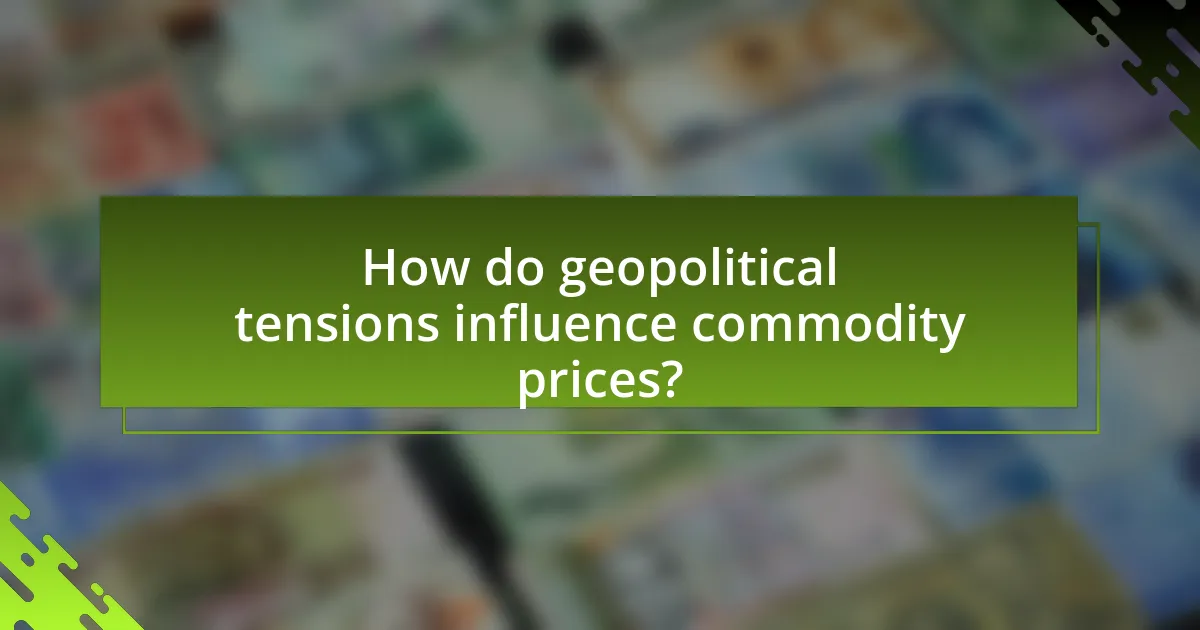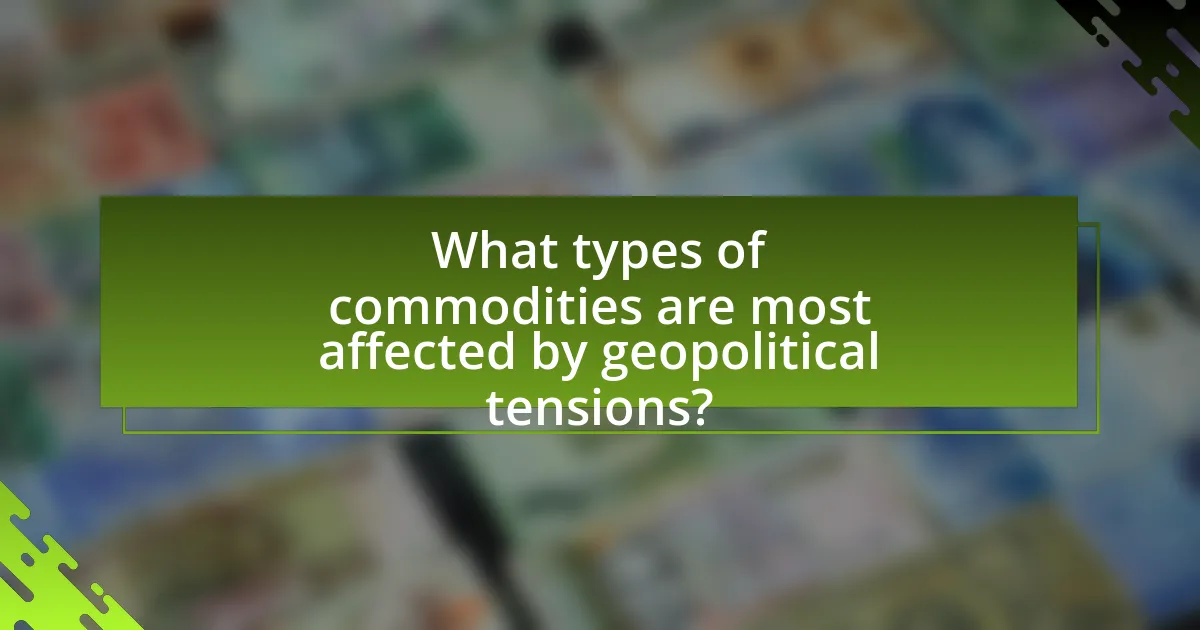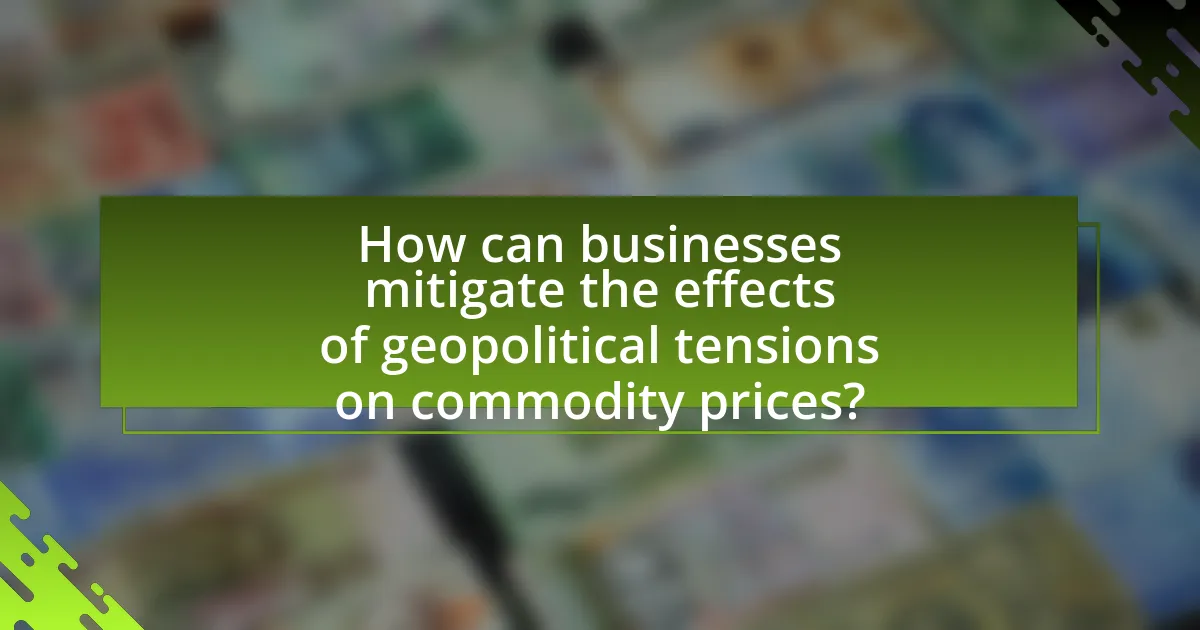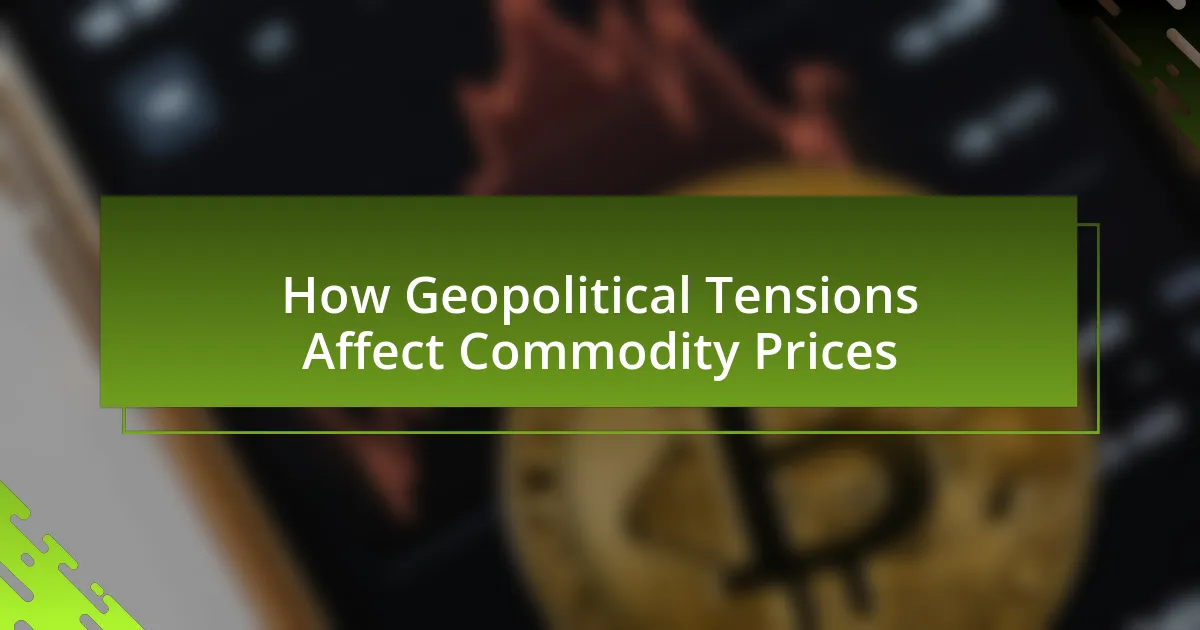Geopolitical tensions play a critical role in influencing commodity prices by creating uncertainty in supply chains and altering market perceptions. Key factors such as conflicts, trade policies, and sanctions directly impact the availability and pricing of commodities, particularly energy and agricultural products. Historical examples illustrate how events like the Libyan civil war and the Russian invasion of Ukraine have led to significant price fluctuations in oil and natural gas. Additionally, the article explores how investor sentiment, media coverage, and climate change further contribute to price volatility, while providing strategies for businesses to mitigate risks associated with geopolitical crises.

How do geopolitical tensions influence commodity prices?
Geopolitical tensions significantly influence commodity prices by creating uncertainty in supply chains and affecting market perceptions. For instance, conflicts in oil-producing regions often lead to fears of supply disruptions, which can cause crude oil prices to spike; the 2011 Libyan civil war resulted in a 25% increase in oil prices due to concerns over production halts. Additionally, sanctions imposed on countries like Iran have historically led to reduced oil exports, further driving up prices in global markets. Such tensions can also impact agricultural commodities, as political instability may disrupt farming operations or trade routes, leading to price volatility.
What are the primary geopolitical factors affecting commodity prices?
The primary geopolitical factors affecting commodity prices include conflicts, trade policies, sanctions, and political stability. Conflicts, such as wars or territorial disputes, disrupt supply chains and production, leading to price volatility; for example, the ongoing tensions in the Middle East have historically caused fluctuations in oil prices. Trade policies, including tariffs and trade agreements, can alter market dynamics; the U.S.-China trade war resulted in increased tariffs on various commodities, impacting their prices globally. Sanctions imposed on countries like Iran have restricted oil exports, causing significant price increases due to reduced supply. Lastly, political stability in key producing regions, such as Venezuela or Nigeria, directly influences production levels and, consequently, commodity prices, as instability often leads to decreased output and increased uncertainty in the markets.
How do conflicts and wars impact the supply of commodities?
Conflicts and wars significantly disrupt the supply of commodities by causing production halts, damaging infrastructure, and creating trade barriers. For instance, during the Iraq War, oil production dropped from 2.5 million barrels per day in 2002 to less than 1 million barrels per day in 2003 due to conflict-related disruptions. Additionally, wars can lead to sanctions that restrict the export of essential commodities, further exacerbating supply shortages. Historical examples, such as the impact of the Syrian Civil War on agricultural exports, illustrate how ongoing conflicts can lead to reduced availability of food commodities in global markets.
What role do sanctions play in commodity pricing?
Sanctions significantly influence commodity pricing by restricting supply and altering market dynamics. When a country faces sanctions, its ability to export commodities, such as oil or metals, is often curtailed, leading to reduced availability in global markets. For instance, the sanctions imposed on Iran in 2018 resulted in a sharp decline in its oil exports, contributing to increased oil prices globally due to tighter supply. Additionally, sanctions can create uncertainty and volatility in commodity markets, as traders react to potential disruptions. Historical data shows that during periods of heightened sanctions, commodities often experience price spikes, reflecting the market’s response to anticipated shortages.
Why do market perceptions of geopolitical risks matter for commodities?
Market perceptions of geopolitical risks matter for commodities because they directly influence supply and demand dynamics, which in turn affect prices. When geopolitical tensions arise, such as conflicts or sanctions, market participants anticipate potential disruptions in the supply chain of commodities, leading to increased volatility. For instance, the 2011 Libyan civil war caused a significant spike in oil prices due to fears of supply interruptions, demonstrating how perceptions of risk can lead to immediate market reactions. Additionally, commodities like gold often see increased demand as a safe haven during geopolitical uncertainty, further illustrating the impact of market perceptions on commodity pricing.
How do investor sentiments shift in response to geopolitical events?
Investor sentiments typically shift towards increased caution and risk aversion in response to geopolitical events. This shift occurs as investors react to uncertainties surrounding political instability, military conflicts, or diplomatic tensions, which can lead to volatility in financial markets. For instance, during the 2014 Crimea crisis, global stock markets experienced significant declines, reflecting heightened investor anxiety and a flight to safer assets like gold and government bonds. Historical data shows that geopolitical tensions often result in increased demand for commodities perceived as safe havens, further illustrating the direct impact of such events on investor behavior and market dynamics.
What is the impact of media coverage on commodity price fluctuations?
Media coverage significantly influences commodity price fluctuations by shaping market perceptions and investor behavior. When media reports highlight geopolitical tensions, such as conflicts or trade disputes, they often lead to increased volatility in commodity prices due to heightened uncertainty and speculation. For example, during the 2011 Libyan civil war, oil prices surged as media coverage emphasized potential supply disruptions, resulting in a price increase of over 25% within weeks. This demonstrates that timely and impactful media narratives can drive immediate reactions in commodity markets, reflecting the direct correlation between media coverage and price movements.

What types of commodities are most affected by geopolitical tensions?
Energy commodities, particularly oil and natural gas, are most affected by geopolitical tensions. Historical events, such as the 1973 oil crisis and the ongoing conflicts in the Middle East, demonstrate that disruptions in supply due to geopolitical instability can lead to significant price volatility. For instance, the 2022 Russian invasion of Ukraine caused oil prices to surge, reflecting how geopolitical events directly impact energy markets. Additionally, agricultural commodities like wheat and corn are also influenced, as seen when conflicts disrupt production and export routes, leading to increased prices globally.
How do energy commodities respond to geopolitical crises?
Energy commodities typically experience price volatility in response to geopolitical crises. For instance, during the 2011 Libyan Civil War, Brent crude oil prices surged by over 25% due to concerns about supply disruptions. Similarly, the 2022 Russian invasion of Ukraine led to significant spikes in natural gas and oil prices, reflecting fears of reduced supply from a major energy exporter. These price movements are driven by market perceptions of risk, supply chain disruptions, and changes in demand dynamics, illustrating the direct correlation between geopolitical events and energy commodity pricing.
What specific events have historically influenced oil prices?
Specific events that have historically influenced oil prices include geopolitical conflicts, OPEC decisions, and economic sanctions. For instance, the 1973 Oil Embargo by OPEC led to a quadrupling of oil prices due to reduced supply in response to U.S. support for Israel during the Yom Kippur War. Additionally, the Gulf War in 1990 caused a spike in oil prices as fears of supply disruptions emerged. Economic sanctions on Iran, particularly from 2012 onwards, also significantly impacted oil prices by limiting its oil exports, which contributed to global supply constraints. These events illustrate how geopolitical tensions and decisions directly affect oil market dynamics.
How do natural gas prices react to geopolitical instability?
Natural gas prices typically increase in response to geopolitical instability. This reaction occurs because instability often raises concerns about supply disruptions, particularly in regions that are major producers or transit points for natural gas. For instance, during the 2014 Ukraine crisis, natural gas prices surged as fears grew over potential supply interruptions from Russia, which supplies a significant portion of Europe’s natural gas. Historical data shows that prices can spike by as much as 20% or more during periods of heightened geopolitical tensions, reflecting market anxiety and speculative trading behavior.
What agricultural commodities are impacted by geopolitical factors?
Geopolitical factors significantly impact agricultural commodities such as wheat, corn, soybeans, and rice. For instance, conflicts in major producing regions can disrupt supply chains, leading to price volatility. The 2022 Russian invasion of Ukraine, a key wheat exporter, resulted in a dramatic increase in global wheat prices, highlighting how geopolitical tensions can directly affect commodity markets. Additionally, trade sanctions and tariffs can alter the flow of agricultural goods, further influencing prices and availability.
How do trade disputes affect the prices of agricultural products?
Trade disputes lead to increased prices of agricultural products due to tariffs and trade barriers that restrict supply and alter demand dynamics. For instance, when a country imposes tariffs on agricultural imports, the cost of those products rises, making them less competitive in the market. This was evident during the U.S.-China trade dispute, where tariffs on soybeans resulted in a significant price increase for American farmers, with soybean prices rising by approximately 20% in 2018. Additionally, trade disputes can create uncertainty in markets, leading to speculative trading that further drives up prices. Thus, the interplay of tariffs, supply chain disruptions, and market speculation during trade disputes directly impacts agricultural product pricing.
What role does climate change play in the geopolitical landscape of agriculture?
Climate change significantly influences the geopolitical landscape of agriculture by altering crop yields, food security, and resource distribution. As temperatures rise and weather patterns shift, regions that were once agriculturally productive may experience declines in output, leading to increased competition for arable land and water resources. For instance, the Intergovernmental Panel on Climate Change (IPCC) reports that climate change could reduce global agricultural productivity by up to 30% by 2050, exacerbating food shortages and driving up commodity prices. This scarcity can heighten geopolitical tensions, as nations may engage in trade disputes or conflicts over dwindling agricultural resources, further impacting global markets and food supply chains.

How can businesses mitigate the effects of geopolitical tensions on commodity prices?
Businesses can mitigate the effects of geopolitical tensions on commodity prices by diversifying their supply chains and sourcing strategies. By establishing relationships with multiple suppliers across different regions, companies reduce their reliance on any single source, thereby minimizing the impact of disruptions caused by geopolitical events. For instance, during the 2014 Ukraine crisis, companies that had diversified their energy suppliers were better positioned to manage fluctuations in oil and gas prices. Additionally, implementing hedging strategies through financial instruments can protect against price volatility, as evidenced by firms that utilized futures contracts to stabilize costs during periods of uncertainty.
What strategies can companies employ to hedge against price volatility?
Companies can employ several strategies to hedge against price volatility, including the use of financial derivatives, diversification of supply sources, and inventory management. Financial derivatives, such as futures and options contracts, allow companies to lock in prices for commodities, thereby reducing the risk of price fluctuations. For instance, in 2020, companies in the oil sector utilized futures contracts to stabilize costs amid volatile market conditions caused by geopolitical tensions. Diversification of supply sources mitigates risk by ensuring that companies are not overly reliant on a single supplier or region, which can be affected by political instability. Additionally, effective inventory management enables companies to adjust their stock levels based on market conditions, allowing them to respond proactively to price changes. These strategies collectively help companies manage the financial risks associated with price volatility in commodities influenced by geopolitical factors.
How can diversification of supply sources reduce risk?
Diversification of supply sources reduces risk by minimizing dependency on a single supplier or region, which can be affected by geopolitical tensions. When companies source materials from multiple suppliers across different geographic locations, they mitigate the impact of disruptions caused by political instability, trade disputes, or natural disasters. For instance, during the 2020 COVID-19 pandemic, companies that relied on a single country for their supply chains faced significant delays and shortages, while those with diversified sources were able to maintain operations. This strategy not only enhances supply chain resilience but also allows businesses to adapt to fluctuating market conditions and price volatility, ultimately leading to more stable commodity prices.
What financial instruments are available for hedging commodity prices?
Financial instruments available for hedging commodity prices include futures contracts, options, swaps, and exchange-traded funds (ETFs). Futures contracts allow traders to lock in prices for commodities at a future date, providing a direct hedge against price fluctuations. Options give the holder the right, but not the obligation, to buy or sell a commodity at a predetermined price, offering flexibility in hedging strategies. Swaps involve exchanging cash flows related to commodity prices, which can stabilize revenue for producers or costs for consumers. ETFs provide exposure to commodity prices through a diversified portfolio, allowing investors to hedge against price movements without directly trading the underlying commodities. These instruments are widely used in the market to manage risk associated with price volatility, particularly during periods of geopolitical tensions that can disrupt supply chains and affect commodity prices.
What best practices should businesses follow during geopolitical crises?
Businesses should prioritize risk assessment and scenario planning during geopolitical crises. This involves evaluating potential impacts on supply chains, market access, and regulatory changes. For instance, companies like BP and Shell have historically adjusted their operations in response to geopolitical tensions in the Middle East, demonstrating the importance of proactive risk management. Additionally, diversifying suppliers and markets can mitigate risks associated with specific regions, as seen when companies shifted sourcing strategies during the Ukraine crisis in 2014. Establishing clear communication channels with stakeholders ensures transparency and maintains trust, which is crucial during uncertain times.
How can companies stay informed about geopolitical developments?
Companies can stay informed about geopolitical developments by utilizing a combination of real-time news sources, analytical reports, and expert insights. Regularly monitoring reputable news outlets, subscribing to geopolitical analysis services, and engaging with think tanks can provide timely updates on relevant events. For instance, organizations like the Economist Intelligence Unit and Stratfor offer in-depth analysis that can help companies understand the implications of geopolitical changes on markets. Additionally, leveraging social media platforms for real-time updates and participating in industry forums can enhance awareness of emerging geopolitical trends.
What role does scenario planning play in risk management for commodities?
Scenario planning plays a crucial role in risk management for commodities by enabling organizations to anticipate and prepare for various potential future scenarios that could impact commodity prices. This strategic approach allows companies to evaluate the effects of geopolitical tensions, market fluctuations, and supply chain disruptions on their operations and financial performance. For instance, a study by the World Economic Forum highlights that firms employing scenario planning can better navigate uncertainties, as they can develop contingency plans tailored to specific geopolitical developments, such as trade wars or conflicts that may affect commodity supply. By systematically analyzing different scenarios, organizations can make informed decisions, mitigate risks, and optimize their commodity trading strategies.



